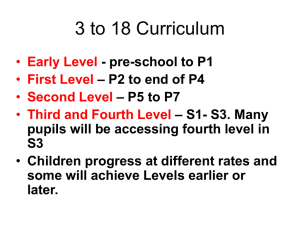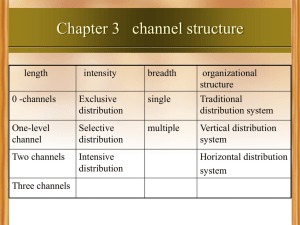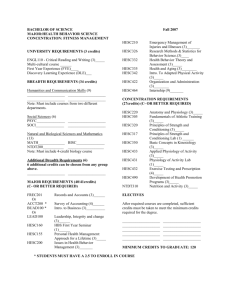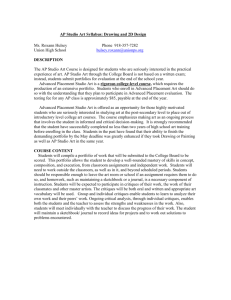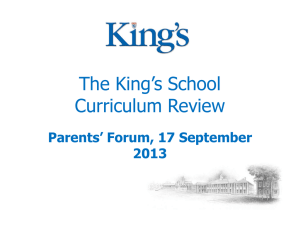AP Contemporary Crafts Syllabus
advertisement
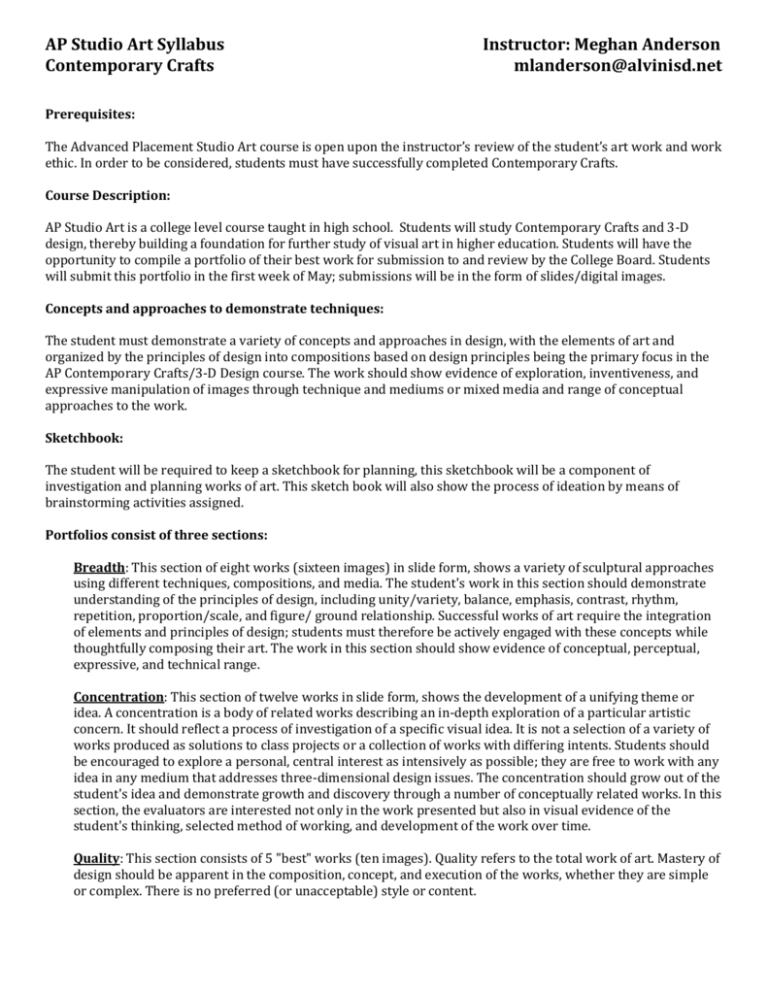
AP Studio Art Syllabus Contemporary Crafts Instructor: Meghan Anderson mlanderson@alvinisd.net Prerequisites: The Advanced Placement Studio Art course is open upon the instructor’s review of the student’s art work and work ethic. In order to be considered, students must have successfully completed Contemporary Crafts. Course Description: AP Studio Art is a college level course taught in high school. Students will study Contemporary Crafts and 3-D design, thereby building a foundation for further study of visual art in higher education. Students will have the opportunity to compile a portfolio of their best work for submission to and review by the College Board. Students will submit this portfolio in the first week of May; submissions will be in the form of slides/digital images. Concepts and approaches to demonstrate techniques: The student must demonstrate a variety of concepts and approaches in design, with the elements of art and organized by the principles of design into compositions based on design principles being the primary focus in the AP Contemporary Crafts/3-D Design course. The work should show evidence of exploration, inventiveness, and expressive manipulation of images through technique and mediums or mixed media and range of conceptual approaches to the work. Sketchbook: The student will be required to keep a sketchbook for planning, this sketchbook will be a component of investigation and planning works of art. This sketch book will also show the process of ideation by means of brainstorming activities assigned. Portfolios consist of three sections: Breadth: This section of eight works (sixteen images) in slide form, shows a variety of sculptural approaches using different techniques, compositions, and media. The student's work in this section should demonstrate understanding of the principles of design, including unity/variety, balance, emphasis, contrast, rhythm, repetition, proportion/scale, and figure/ ground relationship. Successful works of art require the integration of elements and principles of design; students must therefore be actively engaged with these concepts while thoughtfully composing their art. The work in this section should show evidence of conceptual, perceptual, expressive, and technical range. Concentration: This section of twelve works in slide form, shows the development of a unifying theme or idea. A concentration is a body of related works describing an in-depth exploration of a particular artistic concern. It should reflect a process of investigation of a specific visual idea. It is not a selection of a variety of works produced as solutions to class projects or a collection of works with differing intents. Students should be encouraged to explore a personal, central interest as intensively as possible; they are free to work with any idea in any medium that addresses three-dimensional design issues. The concentration should grow out of the student's idea and demonstrate growth and discovery through a number of conceptually related works. In this section, the evaluators are interested not only in the work presented but also in visual evidence of the student's thinking, selected method of working, and development of the work over time. Quality: This section consists of 5 "best" works (ten images). Quality refers to the total work of art. Mastery of design should be apparent in the composition, concept, and execution of the works, whether they are simple or complex. There is no preferred (or unacceptable) style or content. Section I: Quality Rationale: Quality refers to the mastery of 3-D design principles that should be apparent in the concept, form, and execution of the works, whether they are simple or complex. Requirements: For this section, students are asked to submit digital images of their best 5 works, with 2 views of each work, for a total of 10 images. Students should carefully select the works that demonstrate their highest level of accomplishment in 3-D design. The second view of each work should be taken from a different vantage point than the first view and could be a detail if it informs the viewer about a particular aspect of the work. All images should be labeled with dimensions (height 3 width 3 depth) and material. The Web application incorporates space to include this information. The works submitted may come from the Concentration and/or Breadth sections, but they do not have to. They may be a group of related works, unrelated works or a combination of related and unrelated works. Section II: Concentration Rationale: A concentration is a body of related works that demonstrate a student’s commitment to the thoughtful investigation of a specific visual idea. It is NOT a selection of a variety of works produced as solutions to class projects or a collection of works with differing intents. Students should be encouraged to explore a personal, central interest as intensively as possible and are free to work with any idea in any medium that addresses three-dimensional design issues. The concentration should grow out of the student’s idea and demonstrate growth and discovery through a number of conceptually related works. In this section, the evaluators are interested not only in the work presented but also in visual evidence of the student’s thinking, selected method of working, and development of the work over time. Requirements: For this section, 12 images must be submitted, some of which may be details or second views. All images should be labeled with dimensions (height 3 width 3 depth) and material. The Digital Submission Web application incorporates space to include this information. Regardless of the content of the concentration, the works should be unified by an underlying idea that has visual and/or conceptual coherence. The choices of technique, medium, style, form, subject and content are made by the student, in consultation with the teacher. The Web application for development and submission of the Quality, Concentration and Breadth sections of the 3-D Design Portfolio is available in early February. The Concentration section includes spaces for a written commentary, which must accompany the work in this section, describing what the concentration is and how it evolved. Students are asked to respond to the following: 1. Clearly and simply state the central idea of your concentration. 2. Explain how the work in your concentration demonstrates your intent and the exploration of your idea. You may refer to specific images as examples. Although the responses themselves are not scored as pieces of writing, they provide critical information for evaluating the artwork. Thus, they should be well written. Students should be encouraged to formulate their responses to the first question early in the year, as they define the direction their concentration will take. Responses should be concise; the space available for them in the Web application is generous, but the number of characters that can be typed is limited. Responses should be focused on the information requested. Examples of Concentrations: A concentration should consist of a group of works that share a concept — for example, an in-depth study of a particular visual problem or a variety of ways of handling an interesting subject. Some concentrations involve sequential works, such as a series of studies that lead to, and are followed by, more finished works. If a student uses subject matter as the basis of a concentration, the work should show the development of a visual language appropriate for that subject. The investigation of a medium in and of itself, without a strong underlying visual idea, generally does not constitute a successful concentration. Students should not submit group projects, collaborations, and/or documentation of projects that merely require an extended period of time to complete. The list of possible concentration topics is infinite. Because the range of possible concentrations is so wide, the number of works the student creates should be dictated by the focus of the investigation. The chosen visual idea should be explored to the greatest possible extent. In many cases, students will produce more than 12 works and select from among them the works that best represent the process of investigation. If a student has works that are not as well resolved as others but that help show the evolution of thinking and of the work, the student should consider including them. The choice of works to submit should be made to present the concentration as clearly as possible. Students may submit second views of some works, for a total of 12 images. It is not necessary to submit images of 12 different works. When preparing to upload the Concentration (Section II) images, the student should give some thought to the sequence of the images on the Web page. There is no required order; rather, the images should be organized to best show the development of the concentration. In most cases, this would be chronological. Students may not submit images of the same work that they submit for Breadth. Submitting images of the same work for Concentration (Section II) and Breadth (Section III) may negatively affect a student’s score. Section III: Breadth Rationale: The student’s work in this section should demonstrate understanding of the principles of design, including unity/variety, balance, emphasis, contrast, rhythm, repetition, proportion/scale and occupied/unoccupied space. The work should show evidence of conceptual, perceptual, and expressive development, as well as technical skill. The student should be introduced to problems in concept, form and materials as they pertain to three-dimensional design. Requirements: For this section, students are asked to submit digital images of 8 three-dimensional works, with 2 views of each work, for a total of 16 images. All images should be labeled with dimensions (height 3 width 3 depth) and material. The Digital Submission Web application incorporates space to include this information. Work submitted in the breadth category may be additive, subtractive, and/or fabricated; may include study of relationships among three-dimensional forms; and may include representational or abstract objects. The best demonstrations of breadth clearly show experimentation and a range of approaches to the work. They do not simply use a variety of media but rather combine a range of conceptual approaches and physical means of creating art. It is possible to do this in a single medium or in a variety of media. When a student chooses to use a single medium — for example, if a Breadth section consists entirely of ceramics — the work must show a variety of applications of design principles. In this category, relief sculptures or very small works, such as jewelry, should be fully visible and should clearly address three-dimensional issues. Students may not submit images of the same work that they are submitting for the Concentration section. Submitting images of the same work for Concentration (Section II) and Breadth (Section III) may negatively affect a student’s score. AP Overarching Goals: 1. Encourage creative and systematic investigation of formal and conceptual issues. 2. Emphasize making art as an ongoing process that involves the student in informed and critical decision making. 3. Help students develop technical skills and familiarize them with the functions of the visual elements. 4. Encourage students to become independent thinkers who will contribute inventively to their culture through the making of art. Instructional Goals: 1. Introduction to Various Art Mediums A. Able to continuously see the world with new eyes, the student will implement this new vision through various art mediums. B. Through observational drawing, students will be able to utilize the process in amore symbiotic application, exploring meaning and interpretation of works of art. 2. Techniques and Interpretations A. The student's experiences will grow, expanding the repertoire of techniques, stretching understanding of art. B. Students will learn art forms, processes, styles, context theories and philosophies together with skills to create, study, and interpret works of art 3. Art Media and Expression A. Create works of art from observation, memory and imagination with a variety of art media, exploring open-ended avenues of expression. B. Identify problems associated with rendering a subject, putting creative solutions into action to realize a finished work. 4. Design Elements and Compositions A. Demonstrate the ability to arrange design elements and visual images in a given amount of time to create various compositions. B. Creatively involve the coordination of ideas, subject matter, symbols, metaphors, and themes into new structures, indicating the student's connection to the world. 5. Perceptual Skills and Artistic Understanding A. Develop perceptual skills and artistic understanding by promoting attention to detail, aesthetic relationships, and expressive content. Curriculum Outline: First Semester: Students will focus on completing the Breadth section of the portfolio. The instructor will provide a list of ideas that serve as starting points for works to be included in the portfolio. Students may choose to use this list of ideas implicitly or modify the assignments to suit their own artistic goals. The ultimate purpose is to compile twenty five accomplished works of art that show the breadth of each student's ability. Second Semester: Each student will choose a unifying theme for his or her Concentration by focusing on personal interests and building on personal artistic strengths. This is all opportunity for the student to develop his or her artistic voice. A concentration should consist of a group of works that share a single theme-for example, an in-depth study of a particular visual problem or a variety of ways to handle an interesting subject. Some concentrations involve sequential works, such as a series of studies that lead to, and are followed by, more finished works. If a student uses subject matter as the basis of a concentration, the work should show the development of a visual language appropriate for that subject. The investigation of a medium in and of itself, without a strong underlying visual idea, generally does not constitute a successful concentration. Students should not submit group projects, collaborations, and/or documentation of projects that merely require an extended period of time to complete. An extensive library of resources including books, DVDs/videos, technology labs, the Internet, etc. are available to the students for research. Additional Assignments: these may include readings, written, oral and /or self-critiques, or research assignments to further enhance the student's art education experience Assessment: Critique: formal group critiques will be held where students will analyze and discuss their own work as well as the work of others. 'The teacher will also discuss and critique artworks individually with each student. Criticism must be constructive in nature, taking into consideration strengths and weaknesses, and identifying strategies for improvement. Self-evaluative rubrics will be used as a measurement tool for the grading of the work. Grades: participation, course assignments, and semester exam grades will be combined for a semester grade. Semester Exam: a semester exam will consist of a reflective essay about the body of work represented as the Concentration portion of the portfolio. The essay will be scored by using prompts; each assigned a numerical value as guidelines for investigative summary. Plagiarism: All artwork submitted for a grade must be original. Work inspired by another person's work must be altered significantly; it may not be a direct copy. Copying directly from photographs is discouraged unless the photograph is altered in the student's work. PLAN FOR GRADING PUPILS IN ESTIMATING CAPACITY AND DEVELOPMENT: Grade of A: SCHOLARSHIP- Ability surpassing requirements of instructor. INITIATIVE - Power of showing independence and resourcefulness. CO-OPERATION - Advancing all group activities ATTITUDE-Definite benefit to class IMPROVEMENT - Increased development Grade of B: SCHOLARSHIP - Exact and meeting all requirements of instructor INITIATIVE– Satisfactory when stimulated by some achievement. CO-OPERATION - Satisfactory in class ATTITUDE- Appreciative and useful to class IMPROVEMENT - Showing progress under direction Grade of C: SCHOLARSHIP - Merely meeting assignments INITIATIVE - Variable CO-OPERATION - Aimless ATTITUDE - Passable IMPROVEMENT - Common, limited Grade of D: SCHOLARSHIP- Not filling class requirements. INITIATIVE - Deficient CO-OPERATION - Unsatisfactory ATTITUDE- Indifferent IMPROVEMENT - None Grade of F: Failing Grade - work not meeting requirements. MINI-RUBRIC 6. EXCELLENT Consistent high quality Evidence of thinking Inventive, imaginative, experimental Successful composition, technique, use of materials Decisive, confident, sensitive 5. STRONG Strong quality, some inconsistencies Evidence of thinking Mostly successful composition, technique and use of materials Fairly confident [and decisive] 4. GOOD Demonstrates success in consistently Some ideational development Some technical competence Sense of purpose, reflection Emerging technical competence 3. MODERATE Sense of effort; problems and ideas unresolved More competent technically than conceptually or vice versa 2. WEAK Weak ideas Lacks sense of exploration Weak technique, composition, drawing Some artistic decisions made 1. POOR Little thought Lack of awareness Poor technique, composition, use of materials
